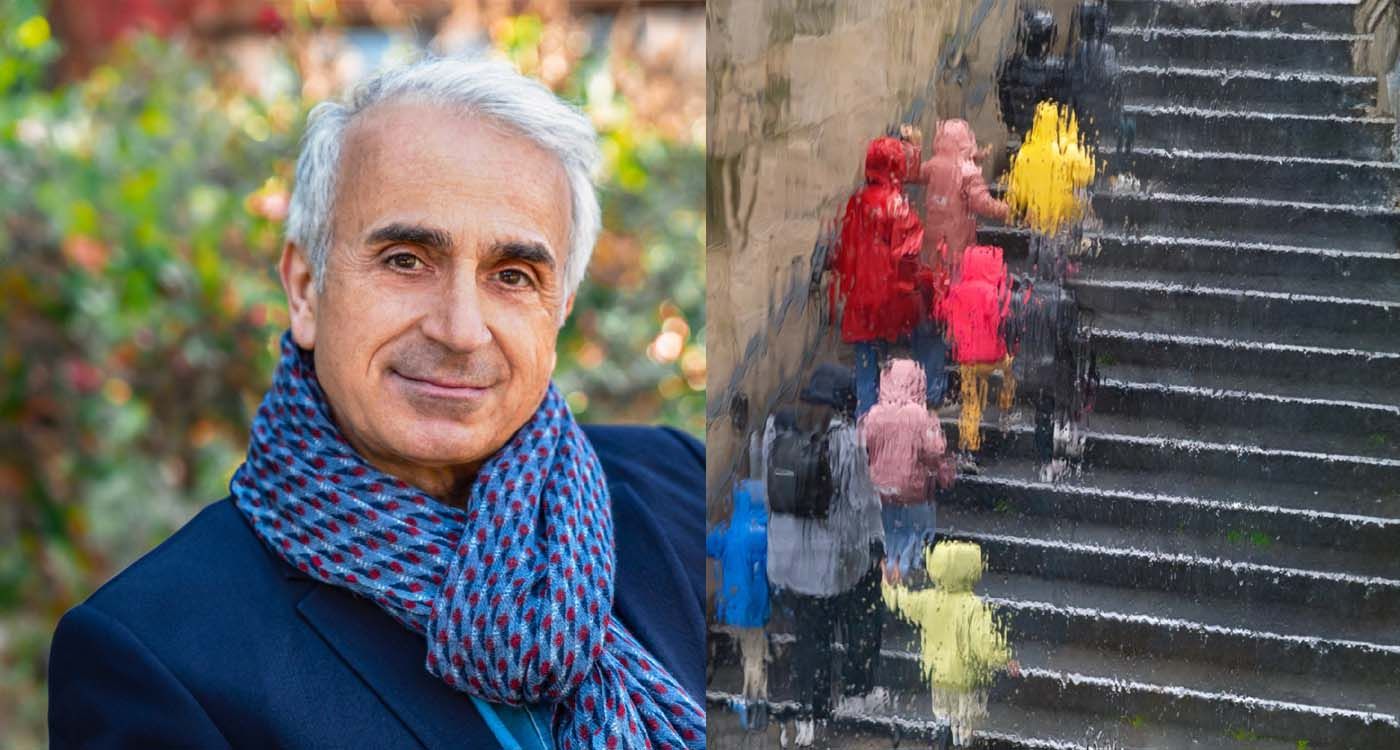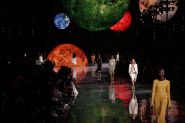
Beneath his ink-dark umbrellas, Paris takes on a different mood. Robert Bared captures the soul of the city in its sorrow, turning every drop of rain into a prism of light, every puddle into a reflection of the sky. Blending photography and writing, he weaves a body of work in which words extend the images, and rain becomes the language of a heightened, sensitive memory. In this second part of our interview, the photographer reflects on the formative experience behind his artistic journey, his dual practice as a writer and visual artist and the literary influences that shape his poetic sensibility.
There are moments that alter the course of a life—brief instants that crystallize an artistic calling. For Robert Bared, it was a summer storm beneath the canopy of the Luxembourg Gardens, some 20 years ago. A Proustian moment in the truest sense—not rooted in childhood, but in its power to set in motion an unrelenting artistic pursuit.
“Yes, a kind of Proustian experience, though not one rooted in childhood,” he recalls, with a precision that reveals the moment’s significance. “It didn’t mark the beginning of my rain photography—I had already been working on that—but it gave me the creative momentum for a deeper artistic purpose.”
On that day, irony intervened: he was without his camera—an absence that would paradoxically prove fertile. “When the storm broke, I took shelter beneath a densely leafed mulberry tree and watched the rain for a long time, the confusion of passersby, the choreography of umbrellas. But that sense of wonder was tinged with frustration: that day, for once, I hadn’t brought my camera.”
The formative absence of his camera, this inability to capture the magical moment, became the driving force behind a photographic quest that has continued for two decades. “Only this frustration explains why my fascination with rain has endured over the years. With each new downpour, with every storm, I desperately try to ‘rediscover’ that ‘lost’ storm: it is that moment, in renewed forms, that I relentlessly bring back to life through my camera lens.”
One cannot help but sense a parallel to Proust's notion of lost time, the endless search for a fleeting moment which only art can hope to revive. For Bared, each rain photograph thus becomes an effort to reconnect with the magic of that original moment of contemplation.
Inner Landscapes
As often happens with artistic obsessions, the theme of rain gradually took hold of Robert Bared, almost unconsciously, eventually evolving into a true visual language, a signature that is instantly recognizable.
“I couldn't say exactly,” he confides when asked when rain became a recurring theme for him. “Over the years, I realized that rain photography, with its dual aesthetic and emotional dimensions, was fertile. It allowed me to free and deepen my artistic expression.”
Rain was more than just a subject, it became a reflection of his own sensibility, a bridge between his aesthetic vision and his inner world. It allowed him to reconcile “two aspects of my temperament: on one hand, my hedonistic love for formal beauty, and on the other, a strong inclination toward contemplation.” This duality is evident in his images, where the pursuit of beauty is always paired with a meditative, almost philosophical depth.
Bared's photographs are not mere representations of the outside world. Rain becomes the medium that allows for this journey through the looking glass, merging the inner and outer worlds, the objective city and the dreamlike city, the captured moment and the reconstructed memory.
This duality in his work—the pleasure of formal composition and the meditative introspection—likely explains why his photographs resonate so deeply. They do not simply show Paris in the rain, they invite viewers on an inner journey, a contemplation that echoes our own memories and emotions in the face of rainy days.
Between Image and Words
Robert Bared is not just a photographer, he is also a writer. This dual practice enriches his artistic approach, creating connections between these two forms of expression, while preserving the independence and uniqueness of each medium.
“When I need to comment on my photographs, I prefer to have them in front of me,” he explains, “precisely to avoid the all-too-common pitfall where words overtake the artwork and end up replacing it.” He is wary of language that might overpower the image, diminish it or distort it. The same caution guides his work as a historian and art critic. He adds, “The same applies, of course, to my analyses of paintings and my reflections on specific artists.”
This careful restraint reflects a deep respect for the image itself, for its ability to express what words cannot. But it doesn’t rule out a meaningful dialogue between writing and photography, a creative interplay that nourishes both practices. “When writing about aesthetics, I sometimes prefer—at least in a first draft—to break away from the work itself and let memory alone guide my thinking and writing. I then return to the piece, whether literary, visual or photographic, to refine and align my reflections.”
In his approach, there is a constant back-and-forth between text and image, between abstract reflection and concrete contemplation. Words sometimes serve as tools for exploration, “clearing the way,” before being pared down—stripped of the excesses of pen or imagination, once they've served their purpose.
However, Bared emphasizes the fundamental independence of his photographic practice, “I almost never ‘illustrate’ a poem with photography. For example, I’ve never tried to visually interpret the beautiful Wet Garden by Henri de Régnier, set to music by Roussel, even though I reference it when describing my artistic process. Similarly, I never consciously seek to capture the atmosphere of a poet or painter in my photographs.”
To him, photography begins with a direct encounter with reality, the captured moment, the shot taken. “In this regard, the photograph remains autonomous at the moment of capture.” It is only later, in a reflective movement, that connections can be made with other works, other artists. He says, “But in hindsight, I can recognize and claim a photograph, through the title I give it, as a ‘tribute’ to a particular artist.”
This approach reveals a creator who understands the distinct qualities of each art form while recognizing the rich connections that can develop between them—a photographer who writes, a writer who photographs, never blending the two practices, but allowing them to mutually enrich one another.
A Musical Melancholy
The texts that supplement Robert Bared's photographs have a distinctive musicality, a gentle melancholy that echoes symbolist poetry. This tone is not accidental, it is deeply rooted in a rich and varied literary background that profoundly influences his visual sensitivity.
“In poetry, I draw inspiration from Verlaine, Apollinaire and even Aragon. Their music strongly influences my artistic sensibility.” This poetic lineage is evident in both his images and his texts, especially the presence of Verlaine, the poet of nuance, suggestion, and “chosen landscapes” where nature and emotion resonate together.
The theme of the “fête galante,” inspired by its visual creator Watteau and embraced by Verlaine, carries a delicate, almost fragile tone. The lovers are depicted as masked and “almost melancholic,” their love is expressed “in a minor key,” as in Verlaine's “Clair de lune.”
This Verlainian melancholy–the light and musical sadness which are not despair, but rather a form of emotional elegance–can be found in many of his photographs. “In some of my photos, the characters seem to be immersed in a dreamlike world, distant through the veil of rain, caught in a melancholic silence rather than tragic solitude.”
The rain, like a delicate veil, softens the edges of reality, giving it the dreamlike and poetic dimension so characteristic of the Verlainian universe. It creates a distance that is not a separation, but a mystery that does not isolate the characters, but wraps them in an aura of reverie. This particular quality of melancholy in his work—never tragic, always musical—is undoubtedly one of the most captivating features of his artistic vision.
From the defining storm in the Luxembourg Gardens to his more recent urban explorations in the rain, his journey outlines a consistent and determined pursuit: the quest for fleeting beauty, for an elusive emotion that only the alchemy of photography can capture—not to freeze it, but to preserve its essence.
By transforming the city into an inner landscape and blending memory with the present moment and literature with photography, Robert Bared offers us a body of work where each raindrop becomes a prism for a unique sensibility.
Website: https://robertbared.com/
Read also: https://thisisbeirut.com.lb/a1311580





Comments